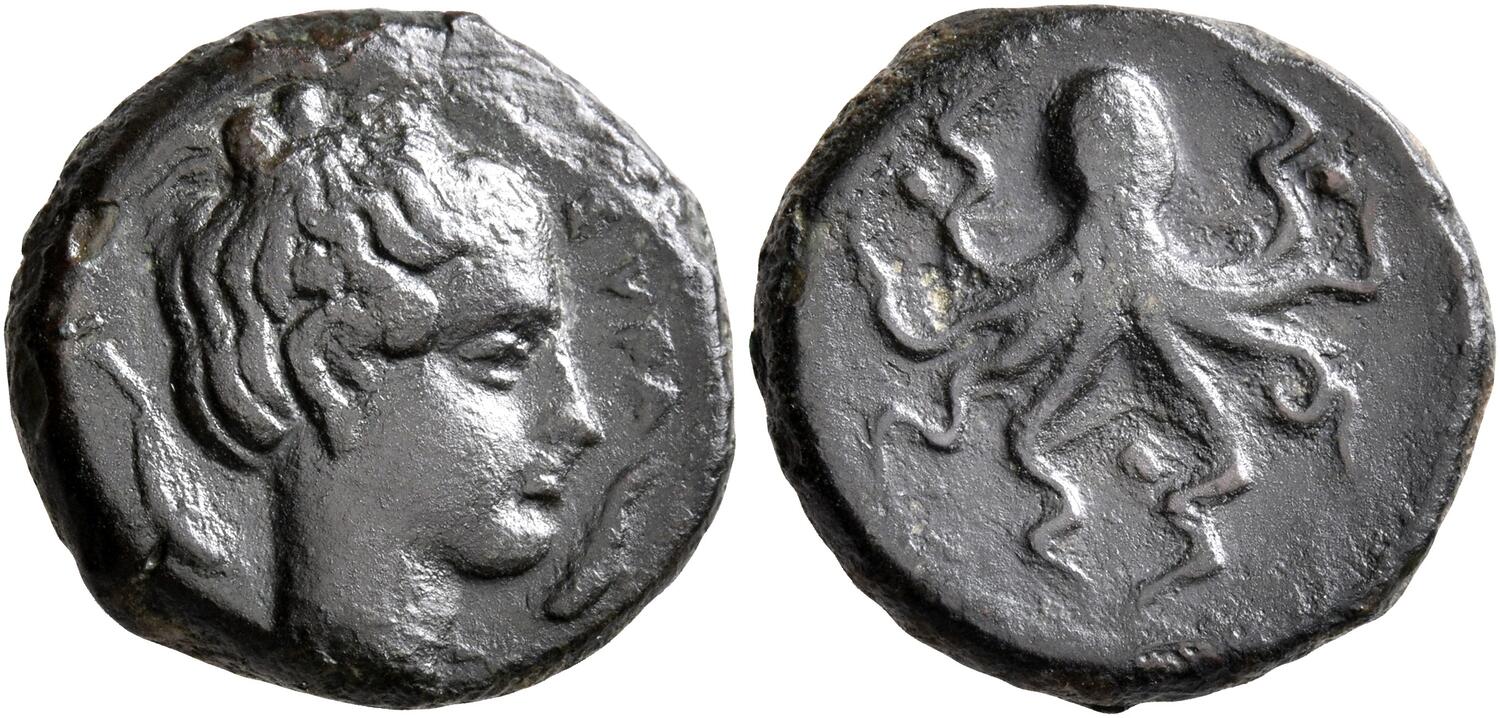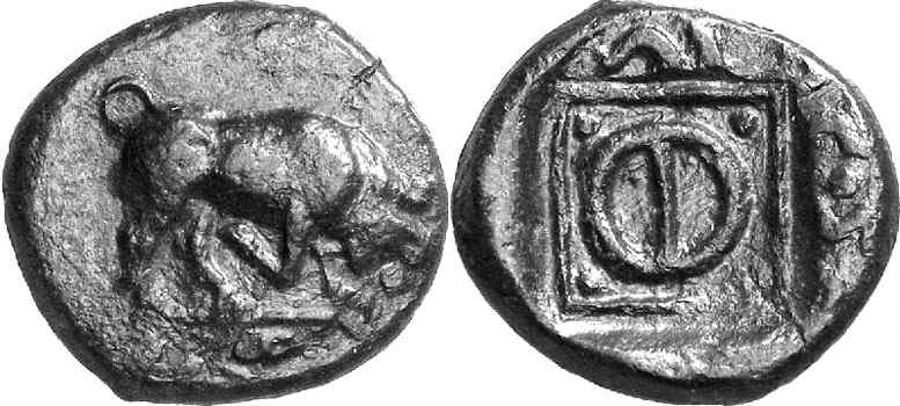3337 - Phlius (AE bull/phi) over Syracuse (Arethusa/octopus) (LHS, 96, May 2006, 94)
From SILVER
420 BCE - 410 BCE | Φ
Images
Overstruck variety

Syracuse_Octopus_(under_Phlius).jpg [1]
Location/history
| Sale(s)Sale(s) ᵖ: | LHS Numismatik, 96, 8 May 2006, no. 94 | |
| Private collection(s)Private collection(s) ᵖ: | BCD Coll. |
Overstriking coin
Description
| ObverseInscription or printing placed on the obverse.: | Bull charging right. | ReverseInscription or printing placed on the reverse.: | Φ (Greek) Φ and globules within linear square. |
Mint and issuing power
| MintIdentifies the place of manufacture or issue of a numismatic object.: | Phlius | Ancient regionAncient region. | Peloponnesus | Modern countryModern country: Greece | AuthorityIdentifies the issuing power. The authority can be "pretended" when the name or the portrait of X is on the coin but he/she was not the issuing power. It can also be "uncertain" when there is no mention of X on the coin but he/she was the issuing power according to the historical sources: |
Chronology
| FromIdentifies the initial date in a range assigned in a numismatic context. 420 BCE toIdentifies the final date in a range assigned in a numismatic context.. 410 BCE | Classical 480-323 BC |
Physical description
| MetalThe physical material (usually metal) from which an object is made.: Bronze |
WeightWeight of the numismatic object (in grams). in grams: 3.733.73 g <br />3,730 mg <br /> | DenominationTerm indicating the value of a numismatic object. Examples: tetradrachm, chalkous, denarius.: dichalkon |
|
| DiameterDescribes diameter of an object (in mm).: 16.516.5 mm <br />1.65 cm <br /> | |||
References
| Coin referenceReference of the Coin: | Coin series referenceReference to coin series study: | HGC 51HGC 5, n° 168 |
Overstruck type
Description
| ObverseInscription or printing placed on the obverse.: | Head of Arethusa to right, her hair tied into a bun at the top of her head, to left and right, dolphin swimming downward | ReverseInscription or printing placed on the reverse.: | Octopus, three pellets (mark of value) around |
Mint and issuing power
| MintIdentifies the place of manufacture or issue of a numismatic object. ᵖ: | Syracuse | Ancient regionAncient region. ᵖ | Sicily | Modern countryModern country: Italy | AuthorityIdentifies the authority in whose name (explicitly or implicitly) a numismatic object was issued. ᵖ: |
Chronology
| FromIdentifies the initial date in a range assigned in a numismatic context. 466 BCE toIdentifies the final date in a range assigned in a numismatic context.. 405 BCE | Classical 480-323 BC |
Physical description
| DenominationTerm indicating the value of a numismatic object. Examples: tetradrachm, chalkous, denarius. ᵖ: | uncia |
References
| Coin type referenceReference to coin series study ᵖ: | Calciati 19952Calciati 1995, no. 1, SNG ANS 5 Sicily3SNG ANS 5 Sicily, nos. 376-381, HGC 24HGC 2, 1428 |
Additional data
| Frequency of overstrikesFrequency of overstrikes: | exceptional | Level of confidenceLevel of confidence of the identification: | strong |
| RemarksRemarks: | Said to have been found in the northern Peloponnesos. The bronze coinage of Phlious has hitherto been thought to have begun c. 400, but there can be no doubt that the present coin was struck somewhat earlier. The fact that the reverse was struck from a die used to produce silver hemidrachms of the 420s (an amazing occurrence in itself), has to link the coins rather closely in time; but the identity of the undertype makes this coin truly spectacular! Clearly visible on the present reverse, around the incuse square of the Phliasian type, are what appear to be the waving tentacles of an octopus (!), with, in one case, a large pellet between them. This can be nothing other than one of the early (c. 425) onkiai of Syracuse, as Calciati 1(1/20 is a particularly good match) and SNG ANS 376-381: the weight and size is exactly correct (traces of the original obverse can also be seen). Since the original coin is apparently little worn, it must have arrived in Greece shortly after it was issued. This could have occurred around the time of the Peace of Nikias in 421, or after the Athenian defeat at Syracuse in 413, when western travelers would have been easily able to reach Peloponnesian ports without fear of the Athenian fleet. The second known example of this coin is in the Ashmolean, from where BCD received a photograph of it twenty years ago. It was struck from another pair of dies but is clearly overstruck on another Syracusan onkia. | ||
References
- ^ Hoover, Oliver D. (2011), Handbook of Greek Coins 5. Coins of the Peloponnesos, Achaia, Phleiasia, Sikyonia, Elis, Triphylia, Messenia, Lakonia, Argolis, and Arkadia, Sixth to First Centuries BC, Lancaster (PA), 2011.
- ^ Calciati, Romolo (1995), Una collezione di monete di bronzo della Sicilia antica, Milano, Ennerre, 118 p., xxxii p. of plates
- ^ Sylloge Nummorum Graecorum ANS 5. The Collection of the American Numismatic Society. Sicily 3. Syracuse-Siceliotes, New York, 1988,
- ^ Hoover, Oliver D. (2012), The Handbook of Greek Coinage Series. 2. Handbook of the Coins of Sicily (Including Lipara). Civic, Royal, Siculo-Punic, and Romano-Sicilian Issues. Sixth to First Centuries BC, Lancaster-London, 489 p.
